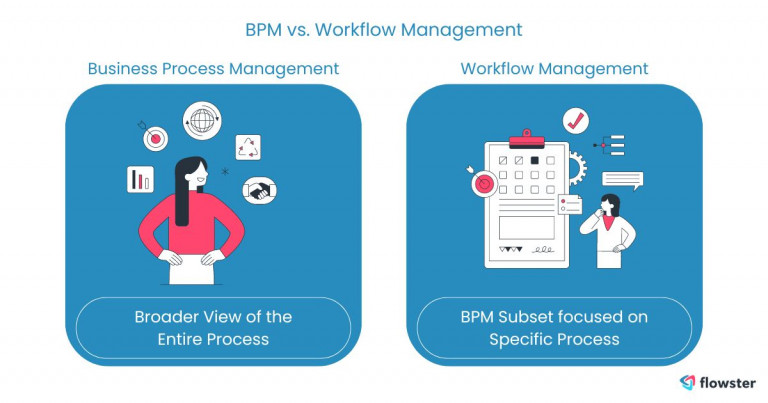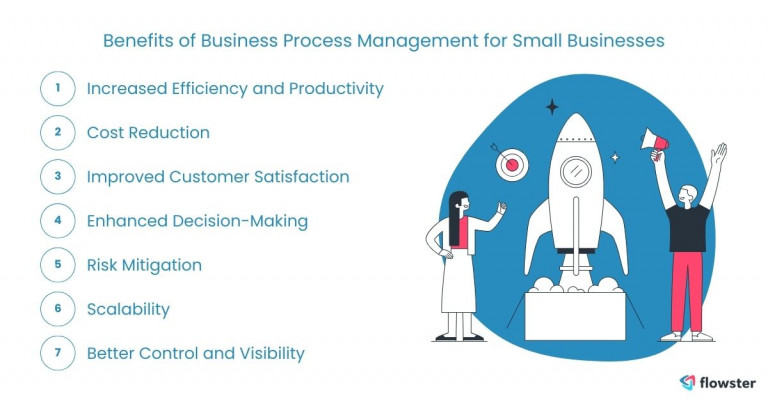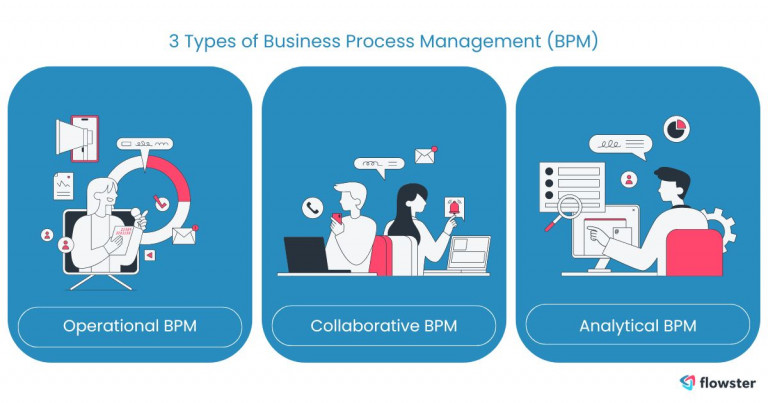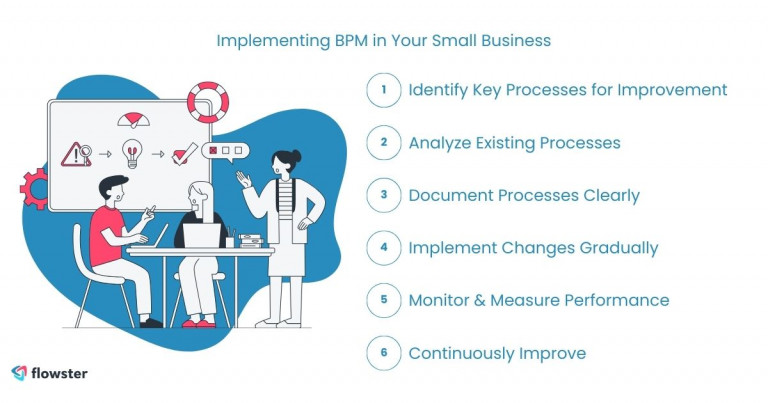Feeling overwhelmed by a never-ending to-do list? Struggling to keep up with increasing customer demands while maintaining profitability? You’re not alone. Many small business owners find themselves buried in operational tasks, hindering their ability to focus on growth and innovation.
This is where business process management (BPM) comes in. At its core, BPM is a systematic approach to streamlining and optimizing the way your business operates. By analyzing and improving your workflows, you can boost efficiency, reduce costs, and enhance overall performance.
This guide is designed specifically for small business owners like you. We’ll delve into the world of BPM, exploring its benefits, different types, and practical steps to implement it in your business. By the end of this post, you’ll have a clear understanding of how BPM can transform your operations and drive your business forward.
Let’s get started!
Article Outline
What is Business Process Management (BPM)?
Business Process Management (BPM) is a strategic discipline focused on designing, managing, and optimizing an organization’s core processes to achieve specific goals. It’s about understanding how work gets done within a business, identifying inefficiencies, and implementing solutions to improve performance, productivity, and customer satisfaction.
Defining BPM
At its core, BPM involves a systematic approach to analyzing and redesigning business processes to eliminate waste, reduce errors, and enhance overall efficiency. It’s about looking at your business as a series of interconnected activities and finding ways to streamline them.
Optimizing Business Processes
A key component of BPM is process optimization. This involves identifying bottlenecks, redundancies, and areas for improvement within your workflows. By focusing on these areas, you can streamline operations, reduce costs, and increase speed and accuracy.
BPM vs. Workflow Management
While often confused, BPM and workflow management are distinct concepts. Workflow management is a subset of BPM that focuses on automating and managing the flow of tasks within a specific process. BPM, on the other hand, takes a broader view, encompassing the entire lifecycle of a process from design to optimization.
Understanding the fundamentals of BPM is crucial for small business owners looking to improve their operations. Let’s explore how BPM can benefit your business in more detail.

Benefits of Business Process Management for Small Businesses
Implementing business process management can yield significant advantages for small businesses. By streamlining operations and optimizing workflows, you can unlock your business’s full potential.
1. Increased Efficiency and Productivity
BPM is synonymous with efficiency and productivity. By identifying and eliminating bottlenecks, automating repetitive tasks, and optimizing workflows, you can significantly reduce turnaround times and increase output. This translates to more time for your team to focus on strategic initiatives and deliver better results.
2. Cost Reduction
Streamlining processes often leads to substantial cost savings. By eliminating unnecessary steps, reducing waste, and optimizing resource allocation, you can lower operational expenses. Additionally, BPM can help identify areas where automation can be implemented, further reducing costs.
3. Improved Customer Satisfaction
When your business processes are efficient and well-defined, it’s easier to deliver exceptional customer experiences. Faster response times, fewer errors, and consistent service levels all contribute to higher customer satisfaction and loyalty.
4. Enhanced Decision-Making
BPM provides valuable data and insights into your business operations. By analyzing process performance, you can make data-driven decisions that drive growth and improve outcomes.
5. Risk Mitigation
BPM helps identify potential risks and vulnerabilities within your business processes. By proactively addressing these issues, you can minimize the impact of disruptions and protect your business.
6. Scalability
As your business grows, BPM ensures that your processes can adapt and scale accordingly. By having well-defined and optimized processes in place, you can handle an increased workload and expand your operations smoothly.
7. Better Control and Visibility
BPM provides a clear overview of your business operations, giving you better control and visibility. By monitoring key performance indicators (KPIs), you can identify areas for improvement and make necessary adjustments.
Understanding the benefits of BPM is essential for recognizing its value to your small business. Let’s explore the different types of BPM to see how they can be applied to your specific needs.

3 Types of Business Process Management (BPM)
Business process management (BPM) encompasses a variety of approaches tailored to different organizational needs. Let’s explore three primary types of BPM.
Operational BPM
Operational BPM focuses on optimizing day-to-day operations. It involves streamlining routine tasks, automating processes, and improving efficiency. This type of BPM is essential for reducing costs, improving productivity, and ensuring consistent results.
Collaborative BPM
Collaborative BPM emphasizes teamwork and collaboration across departments and functions. It focuses on breaking down silos, improving communication, and enabling seamless information sharing. This type of BPM is crucial for fostering innovation, improving decision-making, and enhancing customer experiences.
Analytical BPM
Analytical BPM leverages data and analytics to optimize business processes. By analyzing process performance data, organizations can identify areas for improvement, predict outcomes, and make data-driven decisions. This type of BPM is instrumental in driving continuous improvement and achieving strategic goals.
Understanding the different types of BPM empowers you to select the most appropriate approach for your small business. Let’s delve deeper into the BPM lifecycle to see how these types are implemented in practice.

Key Stages of Business Process Management (BPM)
The BPM lifecycle is a structured approach to implementing and managing business processes. It involves a cyclical process of continuous improvement. Let’s break down the key stages.
Stage 1: Model
The first step in the BPM lifecycle is to identify and document your existing processes. This involves mapping out the steps involved, identifying roles and responsibilities, and understanding the inputs and outputs of each process. By documenting your current processes, you establish a baseline for improvement.
Stage 2: Execute
Once your processes are mapped out, the next step is to implement the designed processes. This may involve changes to workflows, technology, or employee roles. It’s essential to communicate the changes effectively to ensure a smooth transition.
Stage 3: Monitor
Continuous monitoring of process performance is crucial for identifying areas for improvement. By tracking key performance indicators (KPIs), you can measure efficiency, effectiveness, and compliance. This data is invaluable for making informed decisions.
Stage 4: Optimize
The final stage of the BPM lifecycle involves making necessary changes to enhance efficiency and effectiveness. Based on the insights gained from monitoring, you can identify opportunities for automation, streamlining, or redesigning processes. This is an iterative process that should be ongoing.
By following the BPM lifecycle, you can systematically improve your business processes and drive overall performance. Let’s explore some real-world examples of BPM in action to see how it can be applied to different industries.

Real-World Examples of BPM in Small Businesses
To illustrate the practical application of business process management (BPM), let’s explore how it can be implemented across various industries.
BPM in Different Industries
- Retail: A retail store can optimize its inventory management process by implementing BPM. By analyzing sales data and customer behavior, the store can accurately forecast demand, reduce stockouts, and improve order fulfillment times. Retail scheduling can also be streamlined using BPM, ensuring optimal staff coverage during peak hours while minimizing labor costs.
- E-commerce: Online retailers can benefit from BPM by streamlining order processing, shipping, and customer support. Automating repetitive tasks and integrating with shipping carriers can significantly improve efficiency and customer satisfaction.
- Service-based Businesses: A service-based business, such as a consulting firm, can use BPM to manage project workflows, resource allocation, and client onboarding. By standardizing processes, the firm can improve project delivery times and client satisfaction.
Practical Examples of Process Improvements
- Order Fulfillment: Implementing BPM can optimize the order fulfillment process by reducing order processing time, minimizing errors, and improving delivery accuracy.
- Customer Support: By streamlining customer support processes, businesses can reduce response times, improve issue resolution rates, and enhance customer satisfaction.
- Marketing Campaigns: BPM can help optimize marketing campaigns by analyzing campaign performance, identifying successful strategies, and allocating resources effectively.
These examples demonstrate the versatility of BPM and its potential to drive significant improvements in small businesses. Let’s discuss how you can start implementing BPM in your own business.
Flowster's AI-Driven Automation
Implementing BPM in Your Small Business
Now that you understand the benefits and basics of business process management (BPM), it’s time to put it into action in your small business. Here’s a step-by-step guide to get you started.
Identify Key Processes for Improvement
Begin by identifying the core processes that have the most significant impact on your business. Focus on areas that are time-consuming, error-prone, or customer-facing. Prioritize processes based on their potential for improvement and alignment with your business goals.
Analyze Existing Processes
Once you’ve identified key processes, it’s time to analyze how they currently operate. Document the steps involved, identify bottlenecks, and measure performance metrics. This analysis will provide valuable insights into areas for improvement.
Document Processes Clearly
Create clear and detailed process maps to visualize how work flows through your organization. This documentation serves as a foundation for process improvement and facilitates communication among team members.
Implement Changes Gradually
Avoid making drastic changes all at once. Implement improvements in phases to minimize disruptions and allow for adjustments. Start with small, achievable changes and gradually expand your BPM initiatives.
Monitor and Measure Performance
Continuously track key performance indicators (KPIs) to measure the impact of your BPM efforts. This data will help you identify areas for further optimization and demonstrate the value of BPM to your business.
Continuously Improve
BPM is an ongoing journey, not a one-time project. Foster a culture of continuous improvement by encouraging employees to suggest process enhancements. Regularly review and update your process maps to reflect changes in your business.
By following these steps and maintaining a focus on improvement, you can successfully implement BPM in your small business and reap the rewards of increased efficiency, productivity, and customer satisfaction. Let’s wrap up by summarizing the key points discussed in this guide.

Conclusion: Empower Your Business with Business Process Management
By implementing business process management (BPM), small businesses can unlock significant opportunities for growth and success. We’ve explored how BPM can boost efficiency, reduce costs, improve customer satisfaction, and enhance overall business performance.
Remember, the key to successful BPM lies in identifying your business’s unique challenges, analyzing your processes, and making data-driven improvements. By starting small and gradually expanding your BPM initiatives, you can achieve remarkable results.
To kickstart your BPM journey, we invite you to explore our collection of free business process templates and other workflow templates at the Flowster Marketplace. These resources can help you visualize and optimize your processes with ease.
If you need expert guidance or prefer a hands-off approach, Flowster also offers “Done-for-You” BPM services. Our team of experts can assess your business needs, design and implement tailored solutions, and provide ongoing support.
Take the first step towards transforming your business with BPM. Start exploring your options today!





One Response
awesome